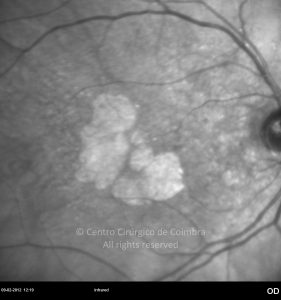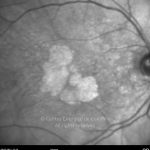Measles is caused by a paramyxovirus that is highly contagious and is typically contracted in childhood. The most serious complications include corneal clouding and blindness, encephalitis, severe diarrhea and related dehydration, ear infections, and pneumonia.
The most common ocular manifestations of acquired meales infection are a self-limited keratitis or conjunctivitis in the early stages of infection, but retinopathy can occur. During the acute stages of retinal involvement, the fundus vessels may appear attenuated and can present optic disc swelling, small hemorrhages, and stellate macular lesions. Retinal findings include macular edema, pigment epithelial abnormalities, choroiditis, whitish retinal infiltrates, serous macular detachments, areas of retinal depigmentation, and optic neuritis.
Congenital infections can occur and the ocular manifestations include cataract and pigmentary retinopathy.
Differential Diagnosis:
- Central serous chorioretinopathy (CSC)
- Retinitis pigmentosa
- Toxoplasmic retinochoroiditis
- Vogt-Koyanagi-Harada disease









